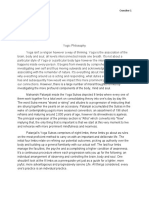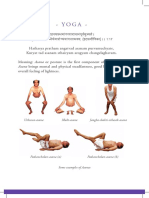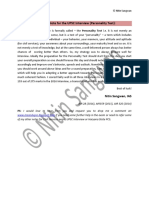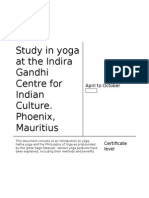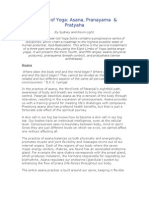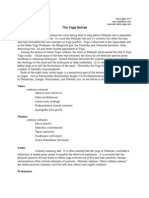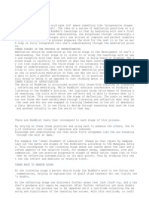The 8 Limbs of Yoga Explained - Ekhart Yoga
The 8 Limbs of Yoga Explained - Ekhart Yoga
Uploaded by
sfcsluckykoriCopyright:
Available Formats
The 8 Limbs of Yoga Explained - Ekhart Yoga
The 8 Limbs of Yoga Explained - Ekhart Yoga
Uploaded by
sfcsluckykoriCopyright
Available Formats
Share this document
Did you find this document useful?
Is this content inappropriate?
Copyright:
Available Formats
The 8 Limbs of Yoga Explained - Ekhart Yoga
The 8 Limbs of Yoga Explained - Ekhart Yoga
Uploaded by
sfcsluckykoriCopyright:
Available Formats
Classes Programs Teachers Articles Resources Academy Sign in Try for free
Articles Philosophy
The 8 Limbs of Yoga explained
The Yoga Sutras of Patanjali refers to 8 limbs of yoga, each of which
o ers guidance on how to live a meaningful and purposeful life.
Learn about each one and how to incorporate them into your
practice.
by Emma Newlyn
What do we mean by the 8 limbs of yoga?
According to Patanjali’s Yoga Sutras, there is an eight-fold path leading to liberation, known as the ‘Ashtanga
Yoga System’ or ‘8 Limbs of Yoga’ (the word ‘ashta’ means ‘eight’ and ‘anga’ means ‘limb’). But how does one
go about attaining this freedom through yoga? Does it come at the cost of an expensive pair of yoga pants?
Can you reach it by signing up to a detox retreat or nally touching your toes? Probably not…
What does yoga mean?
The word ‘yoga’ means to connect, unite or ‘yoke’. The thing we look to connect to is the true Self, also known
as the ‘divine essence’, ‘ultimate self’, or atman. You might also think of this as the soul.
If that way of thinking doesn’t resonate with you, then consider that the word yoga can also
mean separation or disentanglement. The thing we’re disentangling from is whatever stops us from feeling
free, as the ultimate goal of any yoga practice is to attain moksha, meaning liberation or freedom.
What are the 8 Limbs of Yoga?
1. YAMA – Restraints, moral disciplines or moral vows
2. NIYAMA – Positive duties or observances
3. ASANA – Posture
4. PRANAYAMA – Breathing Techniques
5. PRATYAHARA – Sense withdrawal
6. DHARANA – Focused Concentration
7. DHYANA – Meditative Absorption
8. SAMADHI – Bliss or Enlightenment
The 8 Limbs of Yoga Program
More yoga philosophy articles
1. YAMA – Restraints, moral disciplines or moral vows
This rst limb, Yama, refers to vows, disciplines or practices that are primarily concerned with the world
around us, and our interaction with it. While the practice of yoga can indeed increase physical strength and
exibility and aid in calming the mind, what’s the point if we’re still rigid, weak and stressed-out in day-to-
day life?
There are ve Yamas:
Ahimsa (non-violence),
Satya (truthfulness),
Asteya (non-stealing),
Brahmacharya (right use of energy), and
Aparigraha (non-greed or non-hoarding).
Yoga is a practice of transforming and bene tting every aspect of life, not just the 60 minutes spent on a
rubber mat; if we can learn to be kind, truthful and use our energy in a worthwhile way, we will not only
bene t ourselves with our practice, but everything and everyone around us.
In BKS Iyengar’s translation of the sutras ‘Light On The Yoga Sutras’, he explains that Yamas
are ‘unconditioned by time, class and place’, meaning no matter who we are, where we come from, or how
much yoga we’ve practised, we can all aim to instil the Yamas within us.
Read more about the Yamas and Niyamas
2. NIYAMA – Positive duties or observances
The second limb of the 8 limbs of yoga, Niyama, usually refers to internal duties. The pre x ‘ni’ is a Sanskrit
verb which means ‘inward’ or ‘within’.
There are ve Niyamas:
saucha (cleanliness),
santosha (contentment),
tapas (discipline or burning desire or conversely, burning of desire),
svadhyaya (self-study or self-re ection, and study of spiritual texts), and
isvarapranidaha (surrender to a higher power).
Niyamas are traditionally practised by those who wish to travel further along the Yogic path and are intended
to build character. Interestingly, the Niyamas closely relate to the Koshas, our ‘sheaths’ or ‘layers’ leading
from the physical body to the essence within. As you’ll notice, when we work with the Niyamas – from saucha
to isvararpranidhana – we are guided from the grossest aspects of ourselves to the truth within.
3. ASANA – Posture
The physical aspect of yoga is the third step on the path to freedom, and if we’re being honest, the
word asana here doesn’t refer to the ability to perform a handstand or an aesthetically impressive backbend, it
means ‘seat’ – speci cally the seat you would take for the practice of meditation. The only alignment
instruction Patanjali gives for this asana is “sthira sukham asanam”, the posture should be steady and
comfortable.
While traditional texts like the Hatha Yoga Pradipika list many postures such as Padmasana (lotus pose)
and Virasana (hero pose) suitable for meditation, this text also tells us that the most important posture is, in
fact, sthirasukhasana – meaning, ‘a posture the practitioner can hold comfortably and motionlessness’.
The idea is to be able to sit in comfort so we’re not ‘pulled’ by aches and pains or restlessness due to being
uncomfortable. Perhaps this is something to consider in your next yoga class if you always tend to choose the
‘advanced’ posture offered, rather than the one your body is able to attain: “In how many poses are we really
comfortable and steady?”
4. PRANAYAMA – Breathing Techniques
The word Prana refers to ‘energy’ or ‘life source’. It is often describe the very essence that keeps us alive, as
well as the energy in the universe around us. Prana also often describes the breath, and by working with the
way we breathe, we affect the mind in a very real way.
"
Perhaps one of the most fascinating things about Pranayama is the
fact that it can mean two totally different things, which may lead us
in two totally different directions at this point on the path to
freedom….
We can interpret Pranayama in a couple of ways. ‘Prana-yama’ can mean ‘breath control’ or ‘breath restraint’,
or ‘prana-ayama’ which would translate as ‘freedom of breath’, ‘breath expansion’ or ‘breath liberation’.
The physical act of working with different breathing techniques alters the mind in a myriad of ways – we can
choose calming practices like Chandra Bhadana (moon piercing breath) or more stimulating techniques such
as Kapalabhati (shining skull cleansing breath).
Each way of breathing will change our state of being, but it’s up to us as to whether we perceive this as
‘controlling’ the way we feel or ‘freeing’ ourselves from the habitual way our mind may usually be.
5. PRATYAHARA – Sense withdrawal
Pratya means to ‘withdraw’, ‘draw in’ or ‘draw back’, and the second part ahara refers to anything we ‘take in’
by ourselves, such as the various sights, sounds andsmells our senses take in continuously. When sitting for a
formal meditation practice, this is likely to be the rst thing we do when we think we’re meditating; we focus
on ‘drawing in’. The practice of drawing inward may include focussing on the way we’re breathing, so this limb
would relate directly to the practice of pranayama too.
The phrase ‘sense withdrawal’ conjures up images of being able to switch our senses ‘off’ through
concentration, which is why this aspect of practice is often misunderstood.
Instead of actually losing the ability to hear and smell, to see and feel, the practice of pratyahara changes our
state of mind so that we become so absorbed in what it is we’re focussing on, that the things outside of
ourselves no longer bother us and we’re able to meditate without becoming easily distracted. Experienced
practitioners may be able to translate pratyahara into everyday life – being so concentrated and present to the
moment at hand, that things like sensations and sounds don’t easily distract the mind.
Read more in – Pratyahara Reversing the Flow
6. DHARANA – Focused Concentration
Dharana means ‘focused concentration’. Dha means ‘holding or maintaining’, and Ana means ‘other’ or
‘something else’. Closely linked to the previous two limbs; dharana and pratyahara are essential parts of the
same aspect. In order to focus on something, we must withdraw our senses so that all attention is on that
point of concentration. In order to draw our senses in, we must focus and concentrate intently. Tratak (candle
gazing), visualisation, and focusing on the breath are all practices of dharana, and it’s this stage many of us
get to when we think we’re ‘meditating’.
7. DHYANA – Meditative Absorption
The seventh limb is ‘meditative absorption’ – when we become
completely absorbed in the focus of our meditation, and this is when
we’re really meditating. All the things we may learn in class are merely
techniques in order to help us settle, focus and concentrate. The actual
practice of meditation is de nitely not something we can actively ‘do’,
rather it describes the spontaneous action of something that happens as
a result of everything else. Essentially; if you are really meditating, you won’t have the thought ‘oh, I’m
meditating!’…. (sound familiar?)
8. SAMADHI – Bliss or Enlightenment
Many of us know the word samadhi as meaning ‘bliss’ or ‘enlightenment’, and this is the nal step of the
journey of Patanjali’s Yoga Sutras. After we’ve re-organised our relationships with the outside world and our
own inner world, we come to the nale of bliss.
When we look at the word samadhi though, we nd out that ‘enlightenment’ or ‘realisation’ does not refer to
oating away on a cloud in a state of happiness and ecstasy…. Sorry.
Breaking the word in half, we see that this nal stage is made up of two words; ‘sama’ meaning ‘same’ or
‘equal’, and ‘dhi’ meaning ‘to see’. There’s a reason it’s called realisation. It’s because reaching Samadhi is not
about escapism, oating away or being abundantly joyful; it’s about realising the very life that lies in front of
us. The ability to ‘see equally’ and without disturbance from the mind, without our experience being
conditioned by likes, dislikes or habits, without a need to judge or become attached to any particular
aspect; that is bliss.
Seeing life as it is
Just as the theologian Meister Eckhart used the word isticheit meaning ‘is-ness’ as referring to the pure
knowledge of seeing and realising just ‘what is’, this stage is not about attaching to happiness or a sensation
of ‘bliss’, but instead it’s about seeing life and reality for exactly what it is, without our thoughts, emotions,
likes, dislikes, pleasure and pain uctuating and governing it. Not necessarily a state of feeling or being, or a
xed way of thinking; just pure ‘I – am-ness’.
There’s just one catch though – Samadhi isn’t a permanent state…. Patanjali’s Yoga Sutras importantly tell us
that unless we are completely ready, without ‘impressions’ such as attachment, aversion, desires and habits,
and with a completely pure mind, we will not be able to maintain the state of Samadhi for long:
Once the mind is pure and we truly do experience a state of Samadhi we can keep hold of, we
attain moksha, also known as mukti, meaning a permanent state of being liberated, released and free.
Watch: an overview of the 8 Limbs of Yoga with Anat Geiger
Anat gives us an accessible overview of The 8 Limbs of Yoga (part of one of the most well-known works in
yoga philosophy, The Yoga Sutras of Patanjali) – each of which offers guidance on how to live a conscious,
meaningful and purposeful life.
Introduction to the 8 Limbs of Yoga
The 8 Limbs of Yoga Program
Start your free trial
Learn how to put these into action in our 8 week guided program.
More yoga philosophy articles
Applying yoga philosophy to asana practice and beyond
15 inspiring yoga documentaries
Share article
Emma Newlyn
Emma is a 500hr registered yoga teacher, writer and holistic therapist
based in Sussex, UK. With a passion for yoga philosophy and Ayurveda,
she loves bringing these ancient methods to the modern world in an
accessible and easy-to-implement way through her writing and courses.
Emma leads the Yoga, Ayurveda & Holistic Health course in person the
UK and also online Modern Ayurveda & Holistic Health courses, giving
students tools and techniques to enhance their health and wellbeing.
www.emmanewlynyoga.com
Philosophy
Play Pause Connect Support About Apps
Try for free Articles Newsletter signup Give the gift of yoga FAQ iOS
Classes Resources Teachers Redeem gift card Terms and conditions Android
Programs Workshops Contact
Playlists Academy
© 2024 Ekhart Yoga. All rights reserved · Cookie settings
You might also like
- Patanjali's Yoga Sutras: The Definitive Guide To Yogic WisdomNo ratings yetPatanjali's Yoga Sutras: The Definitive Guide To Yogic Wisdom28 pages
- The 8 Limbs of Yoga Explained - Ekhart YogaNo ratings yetThe 8 Limbs of Yoga Explained - Ekhart Yoga6 pages
- Explain Ashtanga Yoga and Its Eight Limbs: 1. Yama100% (1)Explain Ashtanga Yoga and Its Eight Limbs: 1. Yama3 pages
- Bodsphere's+eBook+ ++the+Eight+Limbs+of+Yoga+No ratings yetBodsphere's+eBook+ ++the+Eight+Limbs+of+Yoga+16 pages
- Ashtanga Yoga - Overview of Ashtanga Yoga StepsNo ratings yetAshtanga Yoga - Overview of Ashtanga Yoga Steps4 pages
- Yoga For Beginners: Ashtanga Yoga: The Complete Guide to Master Ashtanga Yoga; Benefits, Essentials, Asanas (with Pictures), Ashtanga Meditation, Common Mistakes, FAQs, and Common MythsFrom EverandYoga For Beginners: Ashtanga Yoga: The Complete Guide to Master Ashtanga Yoga; Benefits, Essentials, Asanas (with Pictures), Ashtanga Meditation, Common Mistakes, FAQs, and Common MythsNo ratings yet
- Raja Yoga - Yoga as Meditation: Educational yoga books, #2From EverandRaja Yoga - Yoga as Meditation: Educational yoga books, #2No ratings yet
- What Is Hot Yoga? What Are The Benefits?: The 8 Limbs of Yoga (Yoga Sutras of Patanjali)100% (1)What Is Hot Yoga? What Are The Benefits?: The 8 Limbs of Yoga (Yoga Sutras of Patanjali)2 pages
- #1 He Revived The Great Moral Teachings of The Sages of The PastNo ratings yet#1 He Revived The Great Moral Teachings of The Sages of The Past31 pages
- Bhagavadgita English Translation of Sri Ramanuja's Sanskrit Commentary - Swami AdidevanandaNo ratings yetBhagavadgita English Translation of Sri Ramanuja's Sanskrit Commentary - Swami Adidevananda18 pages
- Round 7 Rapid Fire: 3. What Is The Name of The First Chapter: Arjuna Vishada YogaNo ratings yetRound 7 Rapid Fire: 3. What Is The Name of The First Chapter: Arjuna Vishada Yoga2 pages
- Instant download Philosophy for Life Teach Yourself The Ideas That Shape Our World and How To Use Them Mel Thompson pdf all chapter100% (2)Instant download Philosophy for Life Teach Yourself The Ideas That Shape Our World and How To Use Them Mel Thompson pdf all chapter62 pages
- PYQ on Jainism & Buddhism_25815907_2024_07_13_23_40No ratings yetPYQ on Jainism & Buddhism_25815907_2024_07_13_23_408 pages
- The Golden Lotus Sutras of Master Choa Kok Sui - Books On Healing - Books On Spirituality0% (1)The Golden Lotus Sutras of Master Choa Kok Sui - Books On Healing - Books On Spirituality4 pages
- Toh9 84000 The Perfection of Wisdom in Twenty Five Thousand LinesNo ratings yetToh9 84000 The Perfection of Wisdom in Twenty Five Thousand Lines1,911 pages
- Download full (Ebook) Introduction To Buddhist Meditation by Shaw, Sarah ISBN 9780415409001, 9780415408998, 9780203893227, 0415409004, 0415408997, 0203893220 ebook all chapters100% (1)Download full (Ebook) Introduction To Buddhist Meditation by Shaw, Sarah ISBN 9780415409001, 9780415408998, 9780203893227, 0415409004, 0415408997, 0203893220 ebook all chapters81 pages
- The Acceptance of Buddhist Precepts by The Chinese in The Fifth CenturyNo ratings yetThe Acceptance of Buddhist Precepts by The Chinese in The Fifth Century25 pages
- World Meditation Day - The Sahaja Yoga Meditation PerspectiveNo ratings yetWorld Meditation Day - The Sahaja Yoga Meditation Perspective5 pages
- Progressive Stages of Meditation On EmptinessNo ratings yetProgressive Stages of Meditation On Emptiness4 pages
- Pages From Nagarjuna's Middle Way - Mark Siderits-2No ratings yetPages From Nagarjuna's Middle Way - Mark Siderits-22 pages


